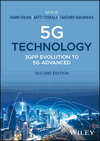Deployment Aspects
Summary
The capabilities of 5G networks do not depend only on 3GPP specifications and on network and user equipment but also on the practical network deployment constraints. 5G technology alone cannot provide great performance if there is not enough spectrum or enough base stations or if interference is not minimized by coordination. Some of those deployment aspects are discussed in this chapter. The chapter considers spectrum resources, discusses the density of the existing base station network, and illustrates the usage of mobile data and the asymmetry between the downlink and uplink. It also discusses base station site solutions, describes Electromagnetic Field considerations, presents network synchronization and coordination requirements, and discusses the 5G overlay solution. Spectrum is the key resource for any wireless communication. The amount of spectrum defines to a large extent the amount of capacity and the data rates that can be achieved by the mobile operator.



